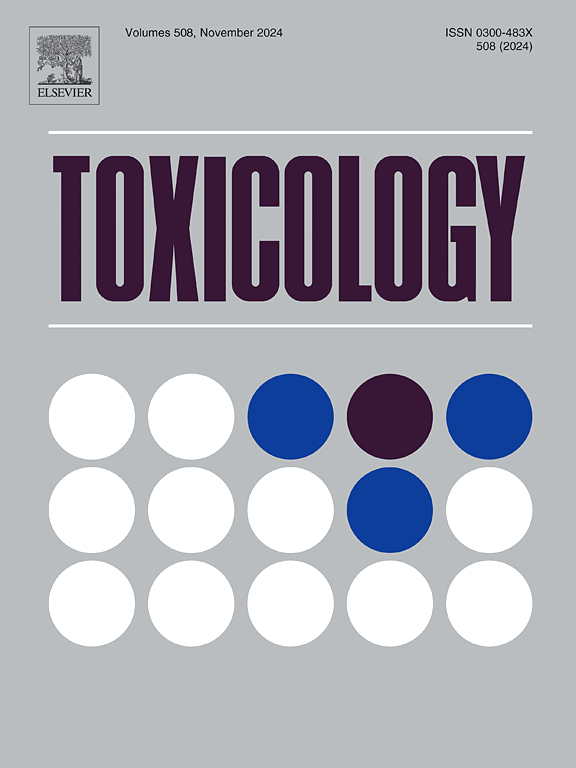阿特拉津暴露诱导TDP-43蛋白易位:环境污染物诱导前额皮质神经退行性变的潜在机制
IF 4.8
3区 医学
Q1 PHARMACOLOGY & PHARMACY
引用次数: 0
摘要
阿特拉津(ATR)是一种广泛使用的除草剂,已被证明对环境产生多种有害影响,特别是在水和土壤污染方面。此外,它对内分泌功能的破坏和对抗生素耐药性的影响强调了迫切需要优先考虑生态系统和人类健康的替代解决方案。因此,本研究的目的是研究阿特拉津对小鼠前额叶损伤的一系列神经毒性作用。本研究结果表明,ATR治疗C57BL/6J小鼠导致认知相关行为缺陷,包括焦虑和抑郁,以及运动障碍。体内分析表明,ATR暴露会导致微观结构水平的神经元突触密度降低,同时也会损害前额叶形态完整性、伤害感受器数量和大脑内整体神经元健康。这些发现共同表明,在这些小鼠中观察到的atr诱导的行为异常涉及突触缺陷。此外,我们的研究结果显示,ATR暴露导致TDP-43表达水平升高,这种表达水平在细胞质中是异位的。这种改变导致mRNP颗粒的功能受损,并导致异常突触缺陷的发展。相反,TDP-43有可能异位定位于线粒体,在那里它激活线粒体未折叠蛋白反应(UPRmt),最终导致线粒体功能障碍。这些发现共同表明TDP-43失调与神经退行性疾病的进展之间存在很强的相关性。对阿特拉津的潜在神经毒性进行进一步调查,可能会提高人们的认识,从而采取更严格的监管措施,研究更安全的替代品,并采取可持续做法,这对保护环境完整性和人类健康至关重要。本文章由计算机程序翻译,如有差异,请以英文原文为准。
Atrazine exposure induces TDP-43 protein translocation: A potential mechanism for prefrontal cortical neurodegeneration induced by environmental pollutants
Atrazine (ATR) is a widely utilized herbicide that has been demonstrated to exert a multitude of deleterious effects on the environment, particularly with regard to water and soil contamination. Moreover, its disruption of endocrine function and implications for antibiotic resistance underscore the urgent need to prioritize alternative solutions for both ecosystems and human health. Therefore, the objective of this study was to investigate a range of neurotoxic effects associated with atrazine-induced damage in the prefrontal lobe of mice. The results of this study indicate that treatment with ATR in C57BL/6 J mice resulted in cognitive-related behavioral deficits, including anxiety and depression, as well as motor impairments. In vivo analyses demonstrated that ATR exposure resulted in a reduction in neuronal synapse density at the microstructural level, while also compromising prefrontal morphological integrity, nociceptor count, and overall neuronal health within the brain. These findings collectively suggest that synaptic deficits are implicated in ATR-induced behavioral abnormalities observed in these mice. Furthermore, our findings revealed that ATR exposure resulted in elevated TDP-43 expression levels that were ectopically localized within the cytoplasm. This alteration led to impaired functionality of mRNP granules and contributed to the development of abnormal synaptic defects. Conversely, TDP-43 has the potential to localize ectopically to mitochondria, where it activates the mitochondrial unfolded protein response (UPRmt), which ultimately results in mitochondrial dysfunction. These findings collectively indicate a strong correlation between TDP-43 dysregulation and the progression of neurodegenerative diseases. Further investigation into the potential neurotoxicity of atrazine may foster heightened awareness, leading to more stringent regulatory measures, research into safer alternatives, and the adoption of sustainable practices, which are essential for safeguarding environmental integrity alongside human health.
求助全文
通过发布文献求助,成功后即可免费获取论文全文。
去求助
来源期刊

Toxicology
医学-毒理学
CiteScore
7.80
自引率
4.40%
发文量
222
审稿时长
23 days
期刊介绍:
Toxicology is an international, peer-reviewed journal that publishes only the highest quality original scientific research and critical reviews describing hypothesis-based investigations into mechanisms of toxicity associated with exposures to xenobiotic chemicals, particularly as it relates to human health. In this respect "mechanisms" is defined on both the macro (e.g. physiological, biological, kinetic, species, sex, etc.) and molecular (genomic, transcriptomic, metabolic, etc.) scale. Emphasis is placed on findings that identify novel hazards and that can be extrapolated to exposures and mechanisms that are relevant to estimating human risk. Toxicology also publishes brief communications, personal commentaries and opinion articles, as well as concise expert reviews on contemporary topics. All research and review articles published in Toxicology are subject to rigorous peer review. Authors are asked to contact the Editor-in-Chief prior to submitting review articles or commentaries for consideration for publication in Toxicology.
 求助内容:
求助内容: 应助结果提醒方式:
应助结果提醒方式:


